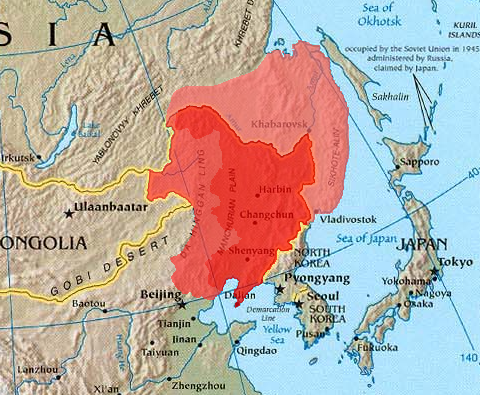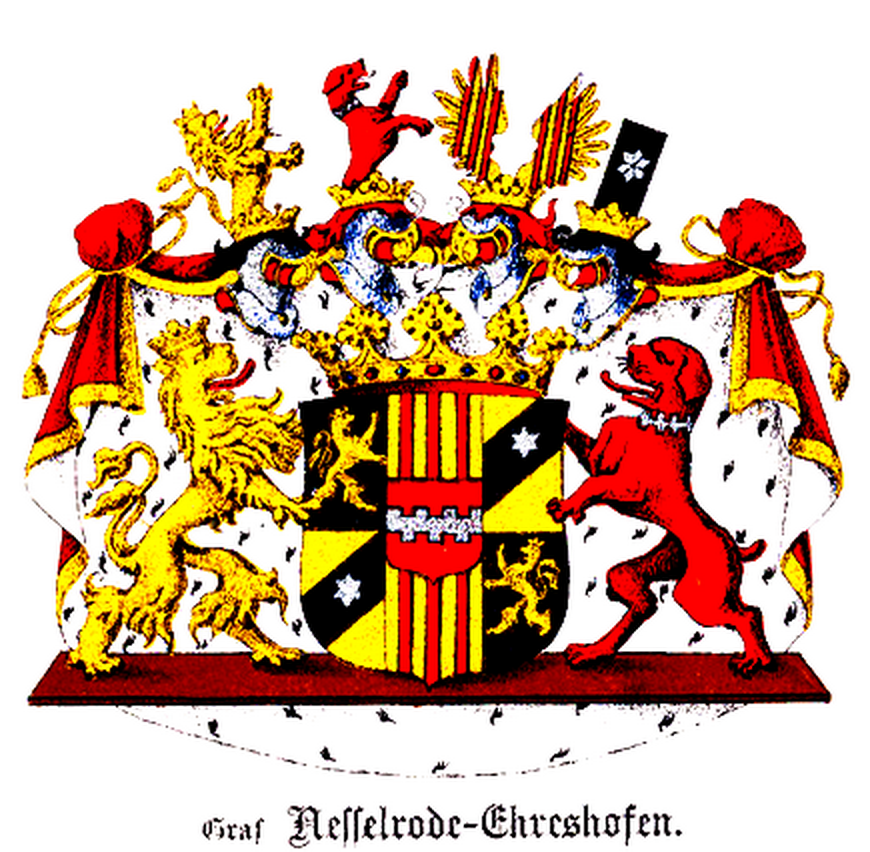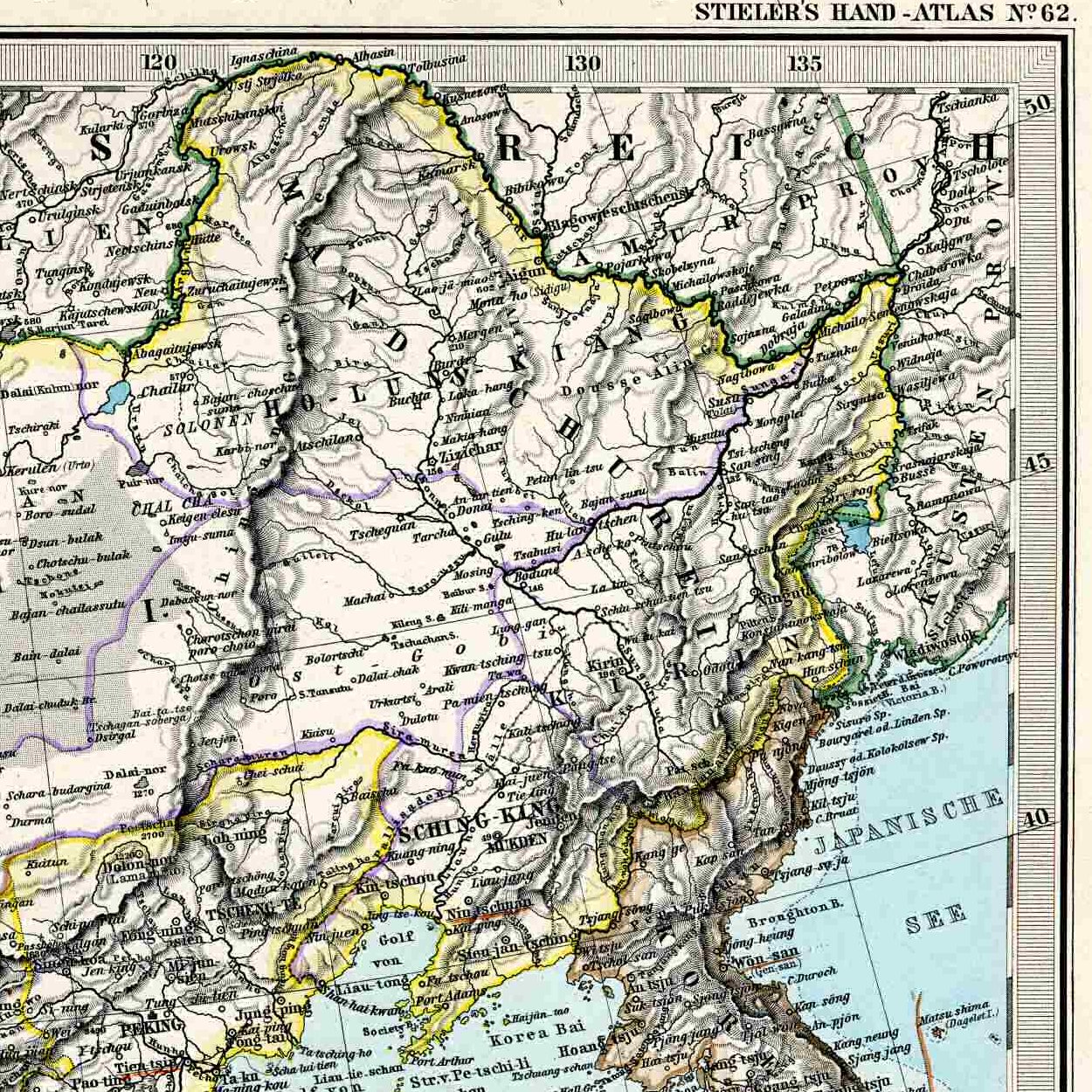|
Amur Annexation
The Amur Annexation was the annexation of the southeast corner of Siberia by the Russian Empire in 1858–1860 through a series of unequal treaties forced upon the Qing dynasty of China. The two areas involved are Priamurye between the Amur River and the Stanovoy Range to the north, and Primorye which runs down the coast from the Amur mouth to the Korean border, including the island of Sakhalin. The territory now known as Outer Manchuria, part of the wider region called Manchuria, was formerly under the sovereignty of Qing China. In the modern-day geography of Russia, ''Priamurye'' ("the Amur Lands") roughly corresponds to the Amur Oblast and the southern half of the Khabarovsk Krai, while ''Primorye'' ("the Maritime Lands") corresponds to the Primorsky Krai (and, possibly, adjacent sections of Khabarovsk Krai). Background Hydrologically, the Stanovoy Range separates the rivers that flow north into the Arctic from those that flow south into the Amur River. Ecologically, th ... [...More Info...] [...Related Items...] OR: [Wikipedia] [Google] [Baidu] |
Manchuria
Manchuria is an exonym (derived from the endo demonym "Manchu") for a historical and geographic region in Northeast Asia encompassing the entirety of present-day Northeast China (Inner Manchuria) and parts of the Russian Far East ( Outer Manchuria). Its meaning may vary depending on the context: * Historical polities and geographical regions usually referred to as Manchuria: ** The Later Jin (1616–1636), the Manchu-led dynasty which renamed itself from "Jin" to "Qing", and the ethnicity from "Jurchen" to "Manchu" in 1636 ** the subsequent duration of the Qing dynasty prior to its conquest of China proper (1644) ** the northeastern region of Qing dynasty China, the homeland of Manchus, known as "Guandong" or "Guanwai" during the Qing dynasty ** The region of Northeast Asia that served as the historical homeland of the Jurchens and later their descendants Manchus ***Qing control of Dauria (the region north of the Amur River, but in its watershed) was contested in 1643 ... [...More Info...] [...Related Items...] OR: [Wikipedia] [Google] [Baidu] |
Taiga
Taiga (; rus, тайга́, p=tɐjˈɡa; relates to Mongolic and Turkic languages), generally referred to in North America as a boreal forest or snow forest, is a biome characterized by coniferous forests consisting mostly of pines, spruces, and larches. The taiga or boreal forest has been called the world's largest land biome. In North America, it covers most of inland Canada, Alaska, and parts of the northern contiguous United States. In Eurasia, it covers most of Sweden, Finland, much of Russia from Karelia in the west to the Pacific Ocean (including much of Siberia), much of Norway and Estonia, some of the Scottish Highlands, some lowland/coastal areas of Iceland, and areas of northern Kazakhstan, northern Mongolia, and northern Japan (on the island of Hokkaidō). The main tree species, depending on the length of the growing season and summer temperatures, vary across the world. The taiga of North America is mostly spruce, Scandinavian and Finnish taiga consists ... [...More Info...] [...Related Items...] OR: [Wikipedia] [Google] [Baidu] |
Karl Nesselrode
Karl Robert Reichsgraf von Nesselrode-Ehreshoven, also known as Charles de Nesselrode ( Russian: Карл Васильевич Нессельроде, ''Karl Vasilyevich Nesselrode''; 14 December 1780 – 23 March 1862) was a Russian German diplomat. For forty years (1816–1856) Nesselrode guided Russian policy as foreign minister. He was also a leading European conservative statesman of the Holy Alliance. Early life Karl von Nesselrode was born at sea near Lisbon, Portugal into the Uradel House of Nesselrode which originated in the Bergisches Land. His father Count Wilhelm Karl von Nesselrode (1724 - 1810), a count of the Holy Roman Empire, served at the time as the ambassador of Catherine the Great , the Russian Empress to Portugal. His mother was Louise :fr:Famille Gontard, Gontard (1746-1785), whose family belonged to Huguenots, Huguenot noble families from Dauphiné that fled from France to Germany in 1700. In deference to his mother's Protestantism he was baptized in ... [...More Info...] [...Related Items...] OR: [Wikipedia] [Google] [Baidu] |
Nikolayevsk-on-Amur
Nikolayevsk-on-Amur (russian: Никола́евск-на-Аму́ре, translit=Nikoláyevsk-na-Amúrye) is a town in Khabarovsk Krai, Russia located on the Amur River close to its liman in the Pacific Ocean. Population: Geography The town is situated on the left bank of the Amur River, from where it flows into the Amur estuary, north of Khabarovsk and from the Komsomolsk-on-Amur railway station. It is the closest significant settlement to the Strait of Tartary separating the mainland from Sakhalin. History Medieval and early-modern history In the late Middle Ages, the people living along the lower course of the Amur ( Nivkh, Oroch, Evenki) were collectively known in China as the "wild Jurchen". The Yuan Dynasty Mongols sent expeditions to this area with an eye toward using the region as a base for attack on Japan, or for defending against the Sakhalin Ainus. According to the History of Yuan, in 1264 the Nivkhs recognized the Mongol sovereignty. In 1263, the Mongols set ... [...More Info...] [...Related Items...] OR: [Wikipedia] [Google] [Baidu] |
Tatar Strait
Strait of Tartary or Gulf of Tartary (russian: Татарский пролив; ; ja, 間宮海峡, Mamiya kaikyō, Mamiya Strait; ko, 타타르 해협) is a strait in the Pacific Ocean dividing the Russian island of Sakhalin from mainland Asia (South-East Russia), connecting the Sea of Okhotsk on the north with the Sea of Japan on the south. It is long, wide, and less than deep at its deepest point. History Yuan dynasty During the Yuan dynasty, the Yuan armies crossed the strait in the Mongol invasions of Sakhalin. Alleged remnants of a Chinese fort dating back to the Mongol Yuan era can be found in Sakhalin today. "Tartary" is an older name used by Europeans to refer to a vast region covering Inner Asia, Central Asia and North Asia. The toponym is derived from the Medieval ethnonym Tartars, which was applied to various Turkic and Mongol semi-nomadic empires, including the Yuan dynasty that ruled over China and the straits of Northeast Asia. Qing dynasty During th ... [...More Info...] [...Related Items...] OR: [Wikipedia] [Google] [Baidu] |
Gennady Nevelskoy
Gennady Ivanovich Nevelskoy (; in Drakino, now in Soligalichsky District, Kostroma Oblast – in St. Petersburg) was a Russian navigator. In 1848 Nevelskoy set out in command of what became the to the area of the present-day Russian Far East, exploring Sakhalin and the outlet of the Amur River. He proved that the Strait of Tartary was not a gulf, but indeed a strait, connected to Amur's estuary by a narrow section (later called Nevelskoy Strait). On 13 August 1850 he founded Nikolayevsk-on-Amur, the first Russian settlement in the region. Not knowing of the work of the Japanese navigator Mamiya Rinzō, who had explored the same area forty years earlier, the Russians took Nevelskoy's report as the first proof that Sakhalin is indeed an island. They renamed the Gulf of Tartary as the Strait of Tartary, and named the northernmost, narrowest section of the strait, the Strait of Nevelskoy, in the captain's honour. It connects the strait's main body (formerly kno ... [...More Info...] [...Related Items...] OR: [Wikipedia] [Google] [Baidu] |
Petropavlovsk-Kamchatsky
Petropavlovsk-Kamchatsky ( rus, Петропавловск-Камчатский, a=Петропавловск-Камчатский.ogg, p=pʲɪtrɐˈpavləfsk kɐmˈtɕatskʲɪj) is a city and the administrative, industrial, scientific, and cultural center of Kamchatka Krai, Russia. As of the 2021 Census its population is 164,900. The city is widely known simply as ''Petropavlovsk'' (literally "city of Peter and Paul"). The adjective ''Kamchatsky'' ("Kamchatkan") was added to the official name in 1924. Geography The city is situated on high hills and surrounded by volcanoes. The surrounding terrain is mountainous enough that the horizon cannot be seen clearly from any point in town. Across Avacha Bay from the city in Vilyuchinsk is Russia's largest submarine base, the Rybachiy Nuclear Submarine Base, established during the Soviet period and still used by the Russian Navy. The city is located from Moscow and about from Vladivostok. History Cossack units visited the ar ... [...More Info...] [...Related Items...] OR: [Wikipedia] [Google] [Baidu] |
Okhotsk
Okhotsk ( rus, Охотск, p=ɐˈxotsk) is an urban locality (a work settlement) and the administrative center of Okhotsky District of Khabarovsk Krai, Russia, located at the mouth of the Okhota River on the Sea of Okhotsk. Population: History Okhotsk was the main Russian base on the Pacific coast from about 1650 to 1860, but lost its importance after the Amur Annexation in 1860. It is located at the east end of the Siberian River Routes on the Sea of Okhotsk where the Okhota and the Kukhtuy Rivers join to form a poor but usable harbor. In 1639 the Russians first reached the Pacific southwest at the mouth of the Ulya River. In 1647 Semyon Shelkovnikov built winter quarters at Okhotsk. In 1649 a fort was built (Kosoy Ostrozhok). In 1653 Okhotsk was burned by the local Lamuts. Although the Russian pioneers were skilled builders of river boats, they lacked the knowledge and equipment to build seagoing vessels, which meant that Okhotsk remained a coastal settlement and not ... [...More Info...] [...Related Items...] OR: [Wikipedia] [Google] [Baidu] |
Nikolay Muravyov-Amursky
Count Nikolay Nikolayevich Muravyov-Amursky (also spelled as Nikolai Nikolaevich Muraviev-Amurskiy; russian: link=no, Никола́й Никола́евич Муравьёв-Аму́рский; – ) was a Russian general, statesman and diplomat, who played a major role in the expansion of the Russian Empire into the Amur River basin and to the shores of the Sea of Japan. The surname Muravyov has also been transcribed as Muravyev or Murav'ev. Early life and career Nikolay Muravyov was born in Saint Petersburg and graduated from the Page Corps in 1827. He participated in the Siege of Varna in the Russo-Turkish War in 1828–1829, and later in suppression of the November Uprising in Poland in 1831. Due to health reasons, he retired from the military in 1833 and returned home to manage his father's estate. However, he returned to active duty in 1838, as General Golovin's aide-de-camp, to serve in the Caucasus region. During one of the campaigns against the mountain people Muravy ... [...More Info...] [...Related Items...] OR: [Wikipedia] [Google] [Baidu] |
Alexander Von Middendorf
Alexander Theodor von Middendorff (russian: Алекса́ндр Фёдорович Ми́ддендорф; tr. ; 18 August 1815 – 24 January 1894) was a zoologist and explorer of Baltic German and Estonian extraction. He is known for his expedition 1843–45 to the extreme north and east of Siberia, describing the effects of permafrost on the spread of animals and plants. Early life Middendorff's mother Sophia Johanson (1782–1868), the daughter of an Estonian farmer, had been sent to Saint Petersburg for education by her parents. There she met with the future director of the St. Petersburg Pedagogical Institute, Theodor Johann von Middendorff (1776–1856), whose father was a Baltic German pastor in Karuse, Estonia. As the two young people came from different social ranks and were unable to marry each other, their daughter Anette (b. 1809) and son Alexander were born out of wedlock. Alexander was born on 18 August 1815 in St. Petersburg, but could not be baptized unti ... [...More Info...] [...Related Items...] OR: [Wikipedia] [Google] [Baidu] |
Nikolai Rezanov
Nikolai Petrovich Rezanov (russian: Николай Петрович Резанов) ( – ), a Russian nobleman and statesman, promoted the project of Russian colonization of Alaska and California to three successive Emperors of All Russia—Catherine the Great, Paul, and Aleksander I. Aleksander I commissioned Rezanov as Russian ambassador to Japan (1804) with the aim of concluding a commercial treaty. In order to get to his post he was appointed co-commander of the First Russian circumnavigation (1803-1806), led by Adam Johann von Krusenstern. Rezanov left the expedition in 1805 when it returned to Kamchatka after visiting Japan (1804-1805). Rezanov wrote a lexicon of the Japanese language and several other works, which are preserved in the library of the Saint Petersburg Academy of Sciences, of which he was a member. Rezanov's greatest legacy proved the founding of the Russian-American Company in 1799. Early life Rezanov was born in Saint Petersburg on March 28, 176 ... [...More Info...] [...Related Items...] OR: [Wikipedia] [Google] [Baidu] |
Grigory Shelikhov
Grigory Ivanovich Shelikhov (Григо́рий Ива́нович Ше́лихов in Russian) (1747, Rylsk, Belgorod Governorate – July 20, 1795 (July 31, 1795 New Style)) was a Russian seafarer, merchant, and fur trader who perpetrated the Awa'uq Massacre. Career Starting in 1775, Shelikhov organized voyages of merchant ships to the Kuril Islands and the Aleutian Islands, in what is now Alaska, for fur trading. In 1783–1786, he led an expedition to the coastal shores of the mainland, where they founded the first permanent Russian settlements in North America. Shelikhov's voyage was done under the auspices of his Shelikhov-Golikov Company, the other owner of which was Ivan Larionovich Golikov. This company was the predecessor of the Russian-American Company, which was founded in 1799. In April 1784, Shelikhov arrived in what he named as Three Saints Bay on Kodiak Island with two ships, the ''Three Hierarchs, Basil the Great, Gregory the Theologian and John Chrysos ... [...More Info...] [...Related Items...] OR: [Wikipedia] [Google] [Baidu] |







.jpg)



